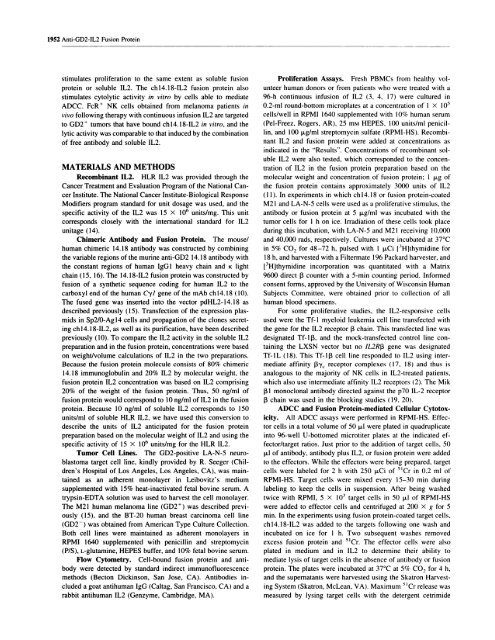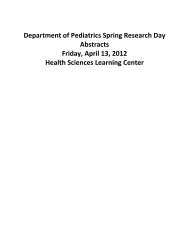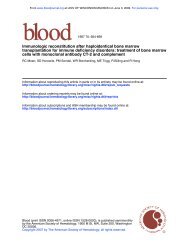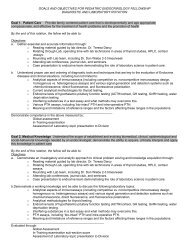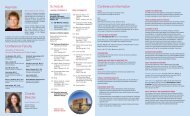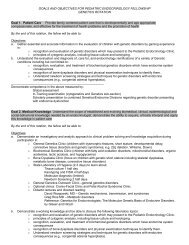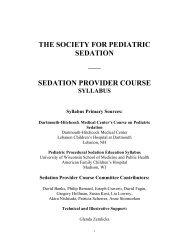Activation of Human Effector Cells by a Tumor Reactive ...
Activation of Human Effector Cells by a Tumor Reactive ...
Activation of Human Effector Cells by a Tumor Reactive ...
You also want an ePaper? Increase the reach of your titles
YUMPU automatically turns print PDFs into web optimized ePapers that Google loves.
1952 Anti-GD2-IL2 Fusion Protein<br />
stimulates proliferation to the same extent as soluble fusion<br />
protein or soluble 1L2. The chl4.l8-1L2 fusion protein also<br />
stimulates cytolytic activity in vitro <strong>by</strong> cells able to mediate<br />
ADCC. FcR NK cells obtained from melanoma patients in<br />
vivo following therapy with continuous infusion 1L2 are targeted<br />
to GD2 tumors that have bound chl4.l8-IL2 in vitro, and the<br />
lytic activity was comparable to that induced <strong>by</strong> the combination<br />
<strong>of</strong> free antibody and soluble 1L2.<br />
MATERIALS AND METHODS<br />
Recombinant IL2. HLR IL2 was provided through the<br />
Cancer Treatment and Evaluation Program <strong>of</strong> the National Cancer<br />
Institute. The National Cancer Institute-Biological Response<br />
Modifiers program standard for unit dosage was used, and the<br />
specific activity <strong>of</strong> the IL2 was 15 X 106 units/mg. This unit<br />
corresponds closely with the international standard for IL2<br />
unitage (14).<br />
Chimenc Antibody and Fusion Protein. The mouse/<br />
human chimeric 14.18 antibody was constructed <strong>by</strong> combining<br />
the variable regions <strong>of</strong> the murine anti-GD2 14.18 antibody with<br />
the constant regions <strong>of</strong> human IgG1 heavy chain and K light<br />
chain (15, 16). The 14.l8-IL2 fusion protein was constructed <strong>by</strong><br />
fusion <strong>of</strong> a synthetic sequence coding for human IL2 to the<br />
carboxyl end <strong>of</strong> the human C-yl gene <strong>of</strong> the mAb chl4. 18 (10).<br />
The fused gene was inserted into the vector pdHL2-l4. 18 as<br />
described previously (15). Transfection <strong>of</strong> the expression plasmids<br />
in Sp2/0-Agl4 cells and propagation <strong>of</strong> the clones secreting<br />
chl4. 18-1L2, as well as its purification, have been described<br />
previously (10). To compare the 1L2 activity in the soluble IL2<br />
preparation and in the fusion protein, concentrations were based<br />
on weight/volume calculations <strong>of</strong> 1L2 in the two preparations.<br />
Because the fusion protein molecule consists <strong>of</strong> 80% chimeric<br />
14.18 immunoglobulin and 20% 1L2 <strong>by</strong> molecular weight, the<br />
fusion protein 1L2 concentration was based on IL2 comprising<br />
20% <strong>of</strong> the weight <strong>of</strong> the fusion protein. Thus, 50 ng/rnl <strong>of</strong><br />
fusion protein would correspond to 10 ng/ml <strong>of</strong> IL2 in the fusion<br />
protein. Because 10 ng/ml <strong>of</strong> soluble IL2 corresponds to 150<br />
units/mi <strong>of</strong> soluble HLR 1L2, we have used this conversion to<br />
describe the units <strong>of</strong> 1L2 anticipated for the fusion protein<br />
preparation based on the molecular weight <strong>of</strong> IL2 and using the<br />
specific activity <strong>of</strong> 15 X 106 units/mg for the HLR IL2.<br />
<strong>Tumor</strong> Cell Lines. The GD2-positive LA-N-S neuroblastoma<br />
target cell line, kindly provided <strong>by</strong> R. Seeger (Children’s<br />
Hospital <strong>of</strong> Los Angeles, Los Angeles, CA), was maintamed<br />
as an adherent monolayer in Leibovitz’ s medium<br />
supplemented with 15% heat-inactivated fetal bovine serum. A<br />
trypsin-EDTA solution was used to harvest the cell monolayer.<br />
The M2l human melanoma line (GD2’) was described previously<br />
(15), and the BT-20 human breast carcinoma cell line<br />
(GD2) was obtained from American Type Culture Collection.<br />
Both cell lines were maintained as adherent monolayers in<br />
RPM! 1640 supplemented with penicillin and streptomycin<br />
(P/S), L-glutamine, HEPES buffer, and 10% fetal bovine serum.<br />
Flow Cytometry. Cell-bound fusion protein and antibody<br />
were detected <strong>by</strong> standard indirect immun<strong>of</strong>luorescence<br />
methods (Becton Dickinson, San Jose, CA). Antibodies ineluded<br />
a goat antihuman IgG (Caltag, San Francisco, CA) and a<br />
rabbit antihuman IL2 (Genzyme, Cambridge, MA).<br />
Proliferation Assays. Fresh PBMCs from healthy volunteer<br />
human donors or from patients who were treated with a<br />
96-h continuous infusion <strong>of</strong> IL2 (3. 4, 17) were cultured in<br />
0.2-ml round-bottom microplates at a concentration <strong>of</strong> 1 X l0<br />
cells/well in RPMI 1640 supplemented with 10% human serum<br />
(Pel-Freez, Rogers, AR), 25 msi HEPES, 100 units/mI penicillin,<br />
and 100 p.g/ml streptomycin sulfate (RPMI-HS). Recombinant<br />
IL2 and fusion protein were added at concentrations as<br />
indicated in the “Results”. Concentrations <strong>of</strong> recombinant soluble<br />
1L2 were also tested, which corresponded to the concentration<br />
<strong>of</strong> 1L2 in the fusion protein preparation based on the<br />
molecular weight and concentration <strong>of</strong> fusion protein: I i.g <strong>of</strong><br />
the fusion protein contains approximately 3000 units <strong>of</strong> IL2<br />
(I 1). In experiments in which chl4. I 8 or fusion protein-coated<br />
M21 and LA-N-S cells were used as a proliferative stimulus, the<br />
antibody or fusion protein at S ig/ml was incubated with the<br />
tumor cells for 1 h on ice. Irradiation <strong>of</strong> these cells took place<br />
during this incubation, with LA-N-S and M2l receiving 10,000<br />
and 40,000 rads, respectively. Cultures were incubated at 37#{176}C<br />
in 5% CO2 for 48-72 h, pulsed with I pCi [3H]thymidine for<br />
18 h, and harvested with a Filterrnate 196 Packard harvester, and<br />
[3H]thymidine incorporation was quantitated with a Matrix<br />
9600 direct 13 counter with a 5-mm counting period. Informed<br />
consent forms, approved <strong>by</strong> the University <strong>of</strong> Wisconsin <strong>Human</strong><br />
Subjects Committee, were obtained prior to collection <strong>of</strong> all<br />
human blood specimens.<br />
For some proliferative studies, the 1L2-responsive cells<br />
used were the Tf-l myeloid leukemia cell line transfected with<br />
the gene for the 1L2 receptor 3 chain. This transfected line was<br />
designated Tf-l , and the mock-transfected control line contaming<br />
the LXSN vector but no IL2R3 gene was designated<br />
Tf-IL (18). This Tf-l3 cell line responded to 1L2 using intermediate<br />
affinity receptor complexes ( 1 7. I 8) and thus is<br />
analogous to the majority <strong>of</strong> NK cells in 1L2-treated patients,<br />
which also use intermediate affinity IL2 receptors (2). The Mik<br />
11 monoclonal antibody directed against the p70 IL-2 receptor<br />
1 chain was used in the blocking studies ( 19. 20).<br />
ADCC and Fusion Protein-mediated Cellular Cytotoxicity.<br />
All ADCC assays were performed in RPMI-HS. <strong>Effector</strong><br />
cells in a total volume <strong>of</strong> SO pi were plated in quadruplicate<br />
into 96-well U-bottomed microtiter plates at the indicated effector/target<br />
ratios. Just prior to the addition <strong>of</strong> target cells, SO<br />
il <strong>of</strong> antibody, antibody plus 1L2, or fusion protein were added<br />
to the effectors. While the effectors were being prepared, target<br />
cells were labeled for 2 h with 250 pCi <strong>of</strong> 5tCr in 0.2 ml <strong>of</strong><br />
RPMI-HS. Target cells were mixed every 15-30 mm during<br />
labeling to keep the cells in suspension. After being washed<br />
twice with RPMI, S x l0 target cells in 50 il <strong>of</strong> RPMI-HS<br />
were added to effector cells and centrifuged at 200 X g for S<br />
mm. In the experiments using fusion protein-coated target cells.<br />
chl4.l8-1L2 was added to the targets following one wash and<br />
incubated on ice for 1 h. Two subsequent washes removed<br />
excess fusion protein and 51Cr. The effector cells were also<br />
plated in medium and in IL2 to determine their ability to<br />
mediate lysis <strong>of</strong> target cells in the absence <strong>of</strong> antibody or fusion<br />
protein. The plates were incubated at 37#{176}Cat 5% CO2 for 4 h,<br />
and the supernatants were harvested using the Skatron Harvesting<br />
System (Skatron, McLean, VA). Maximum 5tCr release was<br />
measured <strong>by</strong> lysing target cells with the detergent cetrimide


